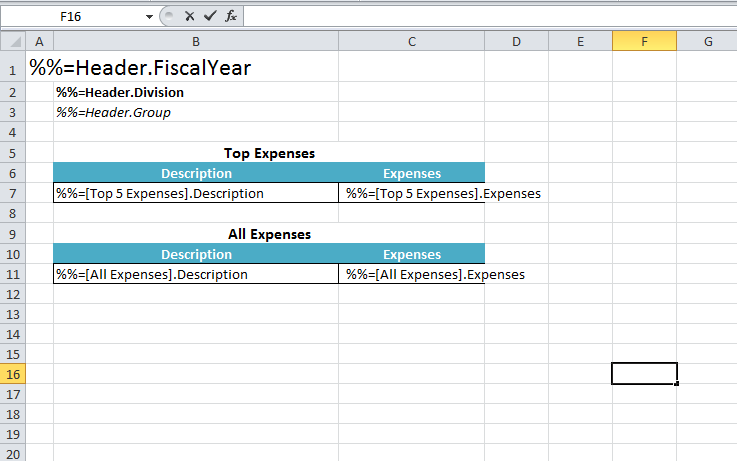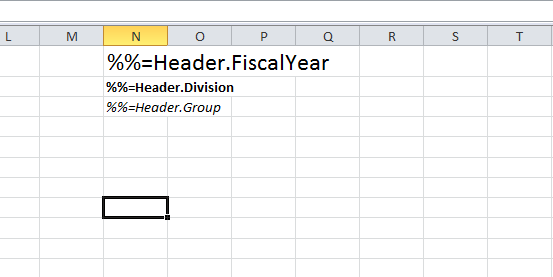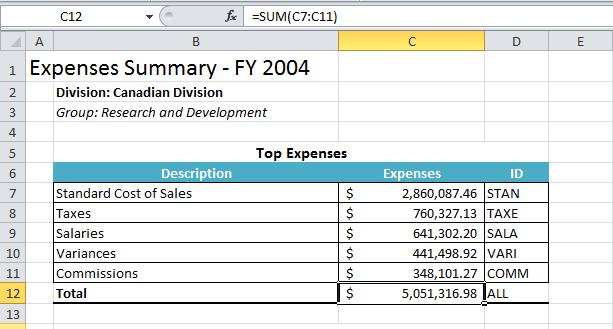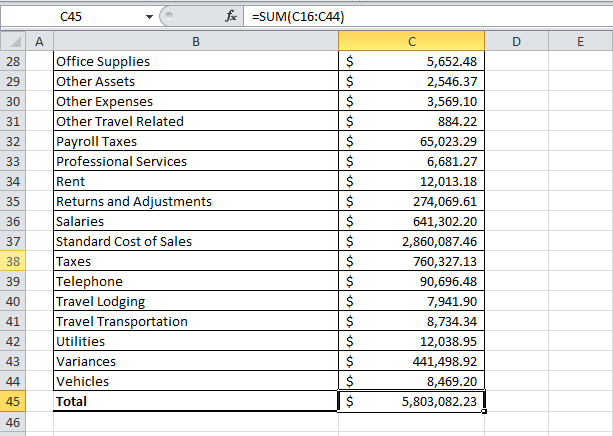Table of Contents | ||||
|---|---|---|---|---|
|
Intro
| Infonote |
|---|
This is Part 2 of a 3-part tutorial series for the Simple Expense Summary scenario. It is recommended that you complete Part 1 - Getting Started before starting this section. |
| Info | ||
|---|---|---|
| ||
There is a downloadable ExcelWriter_Basic_Tutorials.zip with completed templates and code. The completed example of the template is available under templates/part2_template.xlsx), page (Part2.aspx), and code behind (. The code for this part of the tutorial can be found in Part2.aspx.cs) are included in the SimpleExpenseSummary project available for download as part of the ExcelWriter Basics Tutorials. |
This part focuses on adding some Excel formulas to the template file from Part 1. Specifically, this covers combining data marker values with other text, adding a 'Total' row after imported data, and including formulas in imported data rows.
Since the formulas are native Excel functionality, we will only be modifying the template file. There are no changes to the code from Part 1.
Working with Formulas
...
Combining Data Markers with Text
We start with the template file as it was at the end of Part 1:

Right now, the header is set up just to display the values for FiscalYear, Division, and Group. Let's say we want to change the labels to "Expenses Summary - <Fiscal Year>", "Division: <Division>", "Group: <Group>". Data markers must be the only content a cell, they cannot be combined with other text. To get around this, you need to build the text or formula with a reference to the cell the data marker occupies.
1. Move the data markers for %%=Header.FiscalYear, %%=Header.Division, %%=Header.Group to a column off to the right, say Column N.

2. In A1, replace %%=Header.FiscalYear with a formula that builds the desired string with the formula ="Expenses Summary - " & N1.

3. In B2 and B3, replace %%=Header.Division and %%=Header.Group with similar formulas: ="Division: " & N2, ="Group: " & N3.

4. Hide column N so the extra data markers won't be visible.
5. Run the code.
In the output you will see the text combined with the values of the data markers:

Using Inline Formulas
If a formula references a data marker row, ExcelWriter will update the formula to reflect that multiple rows are being inserted. In this section, we'll briefly cover how ExcelWriter handles formulas that are on the data marker row.
...
You will see that the formulas have been stretched and updated as described above.


Combining Data Markers with Text
Right now, the header is set up just to display the values for FiscalYear, Division, and Group. Let's say we want to change the labels to "Expenses Summary - <Fiscal Year>", "Division: <Division>", "Group: <Group>". Data markers must be the only content a cell, they cannot be combined with other text. To get around this, you need to build the text or formula with a reference to the cell the data marker occupies.
1. Move the data markers for %%=Header.FiscalYear, %%=Header.Division, %%=Header.Group to a column off to the right, say Column N.

2. In A1, replace %%=Header.FiscalYear with a formula that builds the desired string with the formula ="Expenses Summary - " & N1.

3. In B2 and B3, replace %%=Header.Division and %%=Header.Group with similar formulas: ="Division: " & N2, ="Group: " & N3.

4. Hide column N so the extra data markers won't be visible.
5. Run the code.
In the output you will see the text combined with the values of the data markers:

Final Code
...
Final Code
| Note |
|---|
For information on writing this code, see Part 1 - Getting Started . |
| Code Block |
|---|
using SoftArtisans.OfficeWriter.ExcelWriter;
...
ExcelTemplate XLT = new ExcelTemplate();
XLT.Open(Page.MapPath("//templates//part1_template.xlsx"));
DataBindingProperties dataProps = XLT.CreateDataBindingProperties();
object[] valuesArray = { "FY 2004", "Canadian Division", "Research and Development" };
string[] columnNamesArray = { "FiscalYear", "Division", "Group" };
XLT.BindRowData(valuesArray, columnNamesArray, "Header", dataProps);
DataTable dtTop5 = GetCSVData(Page.MapPath("//data//Part1_Top5Expenses.csv"));
DataTable dtAll = GetCSVData(Page.MapPath("//data//Part1_AllExpenses.csv"));
XLT.BindData(dtTop5, "Top 5 Expenses", dataProps);
XLT.BindData(dtAll, "All Expenses", dataProps);
XLT.Process();
XLT.Save(Page.Response, "Part1_Output.xlsx", false);
|
...
You can download the code for the Basic ExcelWriter Tutorials as a Visual Studio solution, which includes the Simple Expense Summary.
- OfficeWriter-Basics-csharpExcelWriter_Basic_Tutorials.zip